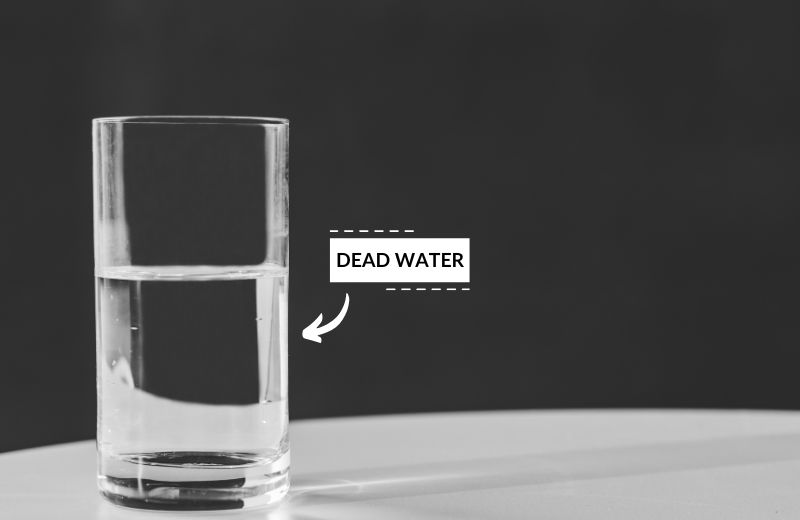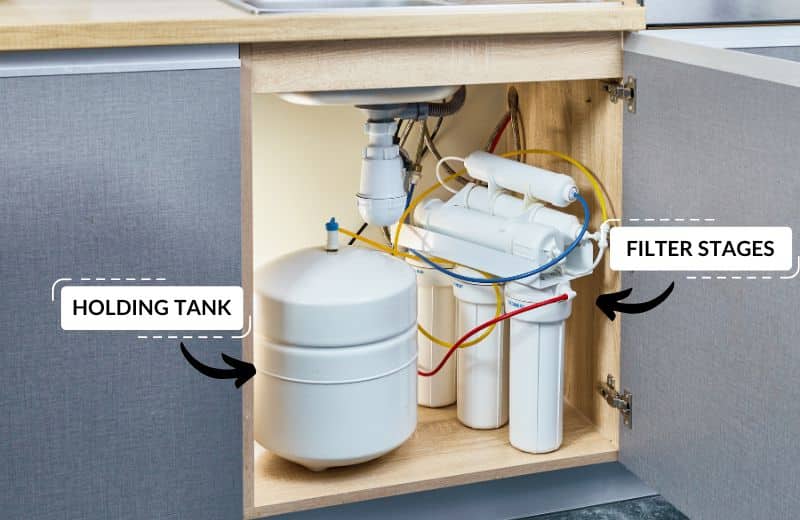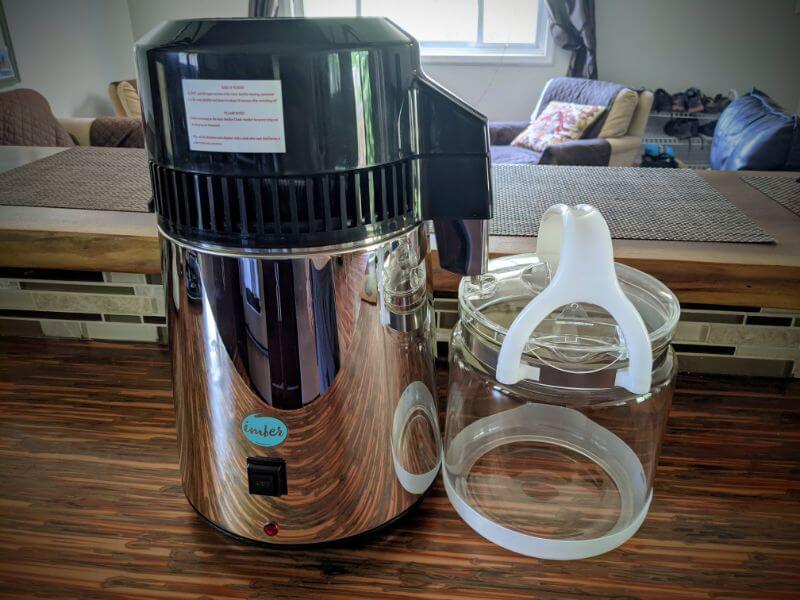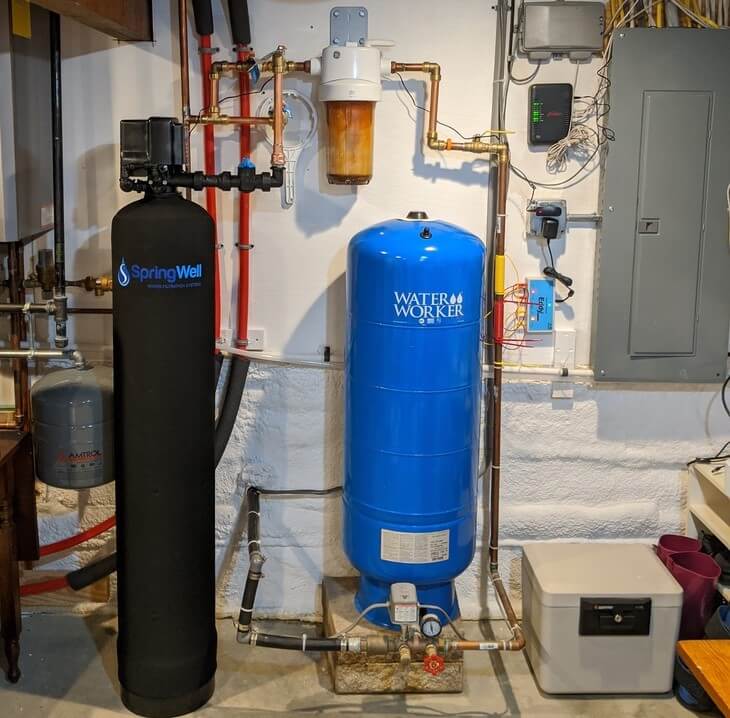Demineralized water is a type of high-purity water that has had the majority of its dissolved solids removed.
In this guide, we’ve shared everything you should know about the different demineralization processes, the uses of demineralized water, and more.
📌 Key Takeaways:
- Demineralized water is water that’s free from select minerals.
- Some of the uses of demineralized water are for manufacturing, laboratory applications, automotive purposes, and various at-home uses.
- Demineralized water is made by processes including reverse osmosis, deionization, ion exchange, and distillation.
Table of Contents
🤔 What Is Demineralized Water?
Demineralized water is water that’s free from, or lacking, mineral impurities.
Not all types of demineralized water are equal – their composition depends on the method of demineralization used.
For instance, some demineralized waters may also be free from all other dissolved solids or impurities, while some may only be free from minerals and trace elements. Some may still contain some minerals, but be lacking in select minerals that have been targeted for a specific purpose.

🚰 What is Demineralized Water Used For?
Demineralized water can be used for industrial and commercial applications, as well as at home.
Some of the common uses of demineralized water are:
1. Drinking
Distilled water and reverse osmosis water are often used for drinking at home.
Water that has been distilled or treated with reverse osmosis is free from virtually all dissolved solids, making it much cleaner and safer to drink than normal tap water. A side effect of these treatments is that trace metals and mineral ions are also removed by these methods.
2. Manufacturing
Products that require water, such as cosmetics, are usually manufactured with pure water, which won’t react with the product’s other ingredients or add any unwanted impurities to the product.
Lipsticks, perfumes, body lotions, and toothpastes are all examples of products that are manufactured with demineralized water.
3. To Prevent System Overheating
Demineralized water can be used in power production, chemical production, manufacturing, or factory settings, to more efficiently cool systems, preventing overheating and helping to maintain optimum temperatures.
4. Laboratory Use
Laboratories use purified water as a control for testing, diluting, and preparing solutions.
Using purified water helps scientists to ensure that data is accurate. Pure, demineralized water helps to maintain the integrity of experiments because it’s free from impurities that could compromise the results.
5. Automotive Purposes
The automotive industry relies on demineralized or deionized water for a number of applications, including in gas-turbine engines, lead-acid batteries, and car cooling systems.
Workers have to be careful with how and where they use demineralized water, as it can be more aggressive towards some metals and other materials.
6. At-Home Use
Deionized water, the most commonly available type of demineralized water, can be used in applications around the home, including as a cleaner, to fill steam irons, and for fish tanks.
Because deionized water has had its minerals removed, it’s particularly ideal for cleaning as it won’t leave behind any residue.

⚗️ How is Water Demineralized?
There are several different processes that can remove minerals from drinking water, including:
Reverse Osmosis
Reverse osmosis is used to purify drinking water in a point-of-use under-sink or countertop unit and can remove up to 100% of minerals from water.
In most reverse osmosis systems, water is treated in a pre-filter, a carbon filter, a semipermeable membrane, and a post-filter. Each stage of treatment removes contaminants of varying sizes and types, including minerals and salts, producing demineralized water that’s also free from the majority of other dissolved solids.
Reverse osmosis is a very effective method of producing demineralized water, and we recommend this method to anyone who wants to create purified water for drinking and other household uses.
The only setback of reverse osmosis systems is that they waste a small amount of water during the purification process. They also can’t remove everything – some volatile organic compounds and dissolved gases can slip through the RO membrane.

Distillation
Another point-of-use water treatment method is water distillation, which uses a countertop unit to produce distilled water. Distilled water contains no minerals and salts – and is free from practically all other existing impurities, too.
A distiller boils water until it evaporates into steam, leaving the impurities behind in the boiling chamber. This water then cools and condenses back into pure water in a separate container. Like most impurities, minerals and salts are unable to vaporize and condense with water.
Distillation is another great option if you want to drink demineralized water that’s also free from harmful impurities. However, the distillation process is incredibly slow – it takes around 4-5 hours for 1 gallon of water to be purified by these systems.
Related:
- Deionized water vs distilled water explained
- The difference between reverse osmosis vs distilled water
- What is dead water?

Deionization
Deionization is a process that removes all charged ions from water while retaining its other impurities. So, water produced by a deionizing machine is demineralized, but not purified.
There are several methods of deionization, and the process usually involves running water through two resin beds with opposite charges. The resin beads will attract the positively and negatively charged ions, pulling them out of the water. H+ and OH- are released into the water to balance its charge.
Deionization is ideal if you just want to produce demineralized water and you’re not concerned about any other impurities, like heavy metals and chemicals, which DI can’t remove.
Ion Exchange
Ion exchange resins (which are found in water softeners) can also be used to remove minerals from water. These resins replace unwanted minerals with other dissolved ions.
Different ion exchange resins can be used to target different minerals in water. A cation resin is typically regenerated with sodium ions and is used to remove calcium and magnesium minerals from water.
Ion exchange water softeners don’t produce completely demineralized water because they only target select minerals. They produce water that’s free from calcium and magnesium, but still contains trace levels of any other minerals present. Typically, these systems are installed for whole-home benefits at water’s point of entry.

👨🔧 Related: What’s the difference between reverse osmosis and water softeners?
Oxidation
Oxidation filters remove a specific group of dissolved minerals. These filters can typically remove iron, but they may also remove manganese and sulfur.
In the oxidation process, water is exposed to a filter media (typically greensand or birm), which has a manganese dioxide coating. Here, the mineral ions convert into an insoluble form, where they can be flushed out of the unit when the media becomes saturated with particles.
Oxidation is highly effective, but the process doesn’t remove all minerals.

✅ Benefits Of Demineralizing Water
Demineralizing water has several positive outcomes, depending on the intended use of the water.
Some of the benefits of demineralizing water include:
- Prevents damage to industrial equipment
- Prevents soil pH alteration in agricultural settings
- Extends water heater & appliance lifespan
- Offers a neutral starting point for medicine production
- Reduces mineral spotting & soap scum
- Ensures neutral drinking water taste
⛔️ Demineralized Water Limitations
There are a few limitations of the demineralization process.
While demineralized water is technically free from all mineral ions, it may still contain very small concentrations of dissolved minerals.
This might mean that demineralized water doesn’t quite live up to expectations when used in various industrial, manufacturing, and laboratory applications.
❔ Frequently Asked Questions
Is Demineralized Water the Same As Distilled Water?
Distilled water is an example of a particular type of demineralized water. Demineralized water is a term used broadly to describe a solution that has had its minerals, such as calcium and magnesium, removed. Distilled water is one of the purest demineralized drinking water options available, as it has a very low impurity content as well as containing no minerals.
Can You Buy Demineralized Water?
Yes, you can buy water bottled drinking water that has had its minerals removed using one of the demineralization methods above. Deionized water, distilled water, and reverse osmosis water are all sold by bottled water brands.
Can I Drink Demineralized Water?
Yes, drinking demineralized water is safe, but some methods of demineralization are more suitable for drinking water than others. It’s worth looking for water that’s purified as well as demineralized, since water that has only had its minerals removed has no specific benefits for drinking. Emerging evidence from a WHO report suggests that water with a low mineral content may have unwanted health effects, so make sure you get plenty of minerals from the foods in your diet to make up for the lack of minerals in your water.
👨🔧 Related: Drinking Purified Water (a Registered Dietician’s Guide)
